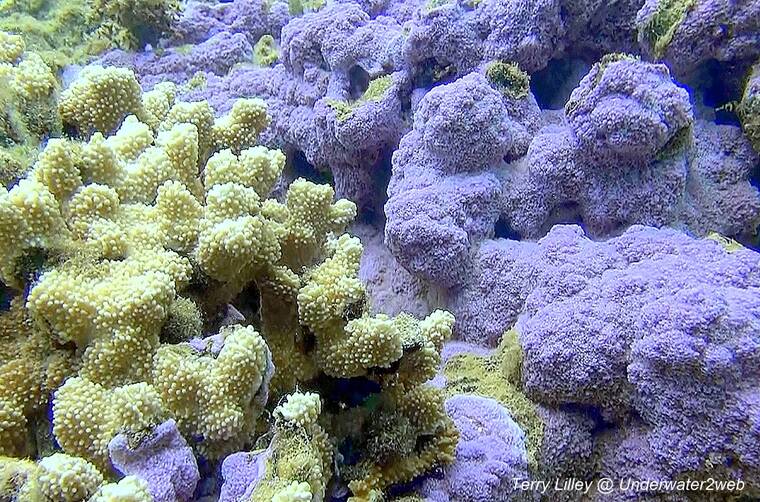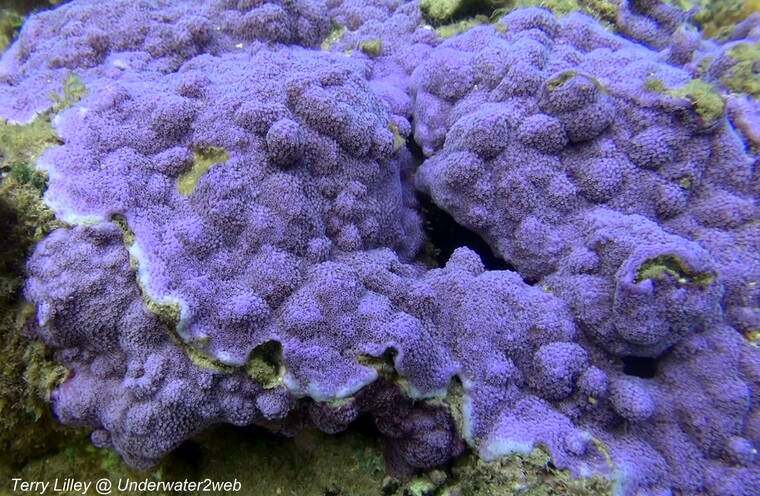Most divers will tell you that Hawaiian corals are fairly boring to look at or photograph, but that is just not the case with the fluorescent, blue-rice coral! Early explorers that sailed into Hanalei Bay wrote about how the reef was bright blue and purple under the crystal-clear waters. Kaua‘i had the largest concentration of blue-rice coral I have ever seen in the entire Pacific Ocean until 2014 when most of it died.
What is unique about this beautiful coral is it grows flat on the reef right in the surf zone from one foot deep to 20 feet deep. In the past, surfers could see the blue reef right below our boards when we paddled out. Coral colors are produced by algae and minerals within the coral tissue and the blue rice coral is easy to recognize and in 2010 much of our coral reefs were covered in this stunning coral which can get up to three feet wide.
Something happened in 2014 that basically wiped out over 95% of the blue rice coral along Kaua‘i’s North Shore.
At first, the coral bleached, turning pure white, and many surfers asked me why the reef had turned white at our favorite surf spots. My answer back was “I don’t know.”
I have been underwater studying Kaua‘i corals for over 20 years, and the massive die-off of the blue-rice coral is still a mystery. When the coral first started to get diseased in 2013, I invited a whole team of scientists over to Kaua‘i from the University of Hawai‘i, the U.S. Geological Survey and the National Oceanic and Atmospheric Administration to do a study.
We tagged over 500 blue-rice corals and took GPS coordinates, and also took samples for DNA studies. We discovered that the corals were being eaten alive by cyanobacteria. We also found out that the Kaua‘i blue-rice coral may be its own distinct species different from the blue-rice corals on other islands. We also discovered that the blue-rice coral was stressed. So what was causing this strange problem?
By 2015, we could not even find one live blue-rice coral along the entire coastline! Could humans have wiped out an entire species of coral in a few short years that took over a million years to evolve here in Kaua‘i? Maybe.
After intense study and testing in the lab and in the sea, we found out that the blue-rice coral has the largest surface area of any coral because it spreads out over the reef and is only about half an inch thick. This makes it more susceptible to environmental changes. When it started to die off, the sea-water temperatures from “climate change” had not started to rise much and the corals throughout Hawai‘i were not yet suffering a bleaching or disease event.
Our blue-rice corals in Kaua‘i were dying in remote parts of the island that had little to no human activity. No sewage or farm chemical runoff and no sunscreen usage. There was simply no real reason for this coral species to be dying along the entire coastline. In 2014, the blue-rice corals on the other Hawaiian Islands and in Tahiti were not diseased and dying, so this was a local event.
In 2014 is when I learned that the U.S. military was practicing underwater submarine weapons training along the Kaua‘i North Shore along with many other countries in the RIMPAC exercises. Could the discharge of electricity into the sea from submarines be killing the blue rice corals?
We set up a lab test to find out and, sure enough, when we added a small electrical current into a saltwater tank with live healthy coral, within a month the coral became diseased and died! It is simple physics when you add an electrical current into saltwater, marine corrosion occurs. Corals are made of a calcium carbonate structure that breaks down if there is an electrical current present.
With this new information we went out onto the reef and put down some electrical-monitoring hardware and, sure enough, we picked up an electrical current in the reef right where the blue-rice corals had died!
We shared this information with the U.S. Navy in 2015, and the Navy said they would move their war games way offshore so there was no chance of them killing any coral.
The great news is, within two years of not seeing any military operations near shore, the blue-rice corals started growing back! Currently, there are thousands of new blue-rice coral colonies growing on Kaua‘i North Shore reefs from Nualolo to Pila‘a!
Just this week, I shot a video of dozens of new blue-rice coral colonies at ‘Anini Beach and in Hanalei Bay. Just go for a snorkel and check out all the new coral growth along the North Shore!
Many people believe that us humans need to crossbreed or engineer new coral species to plant out on our reefs that can better deal with climate change, but I have personally seen entire coral reefs grow back quite quickly when the problem that killed them in the first place is removed. Nature finds a way if we just give it a break.
I am producing an entire movie about the death and regrowth of the Kaua‘i blue-rice corals, and that will be posted up on my marine life educational YouTube site at underwater2web.
Feel free to subscribe to the site, as I put out a new marine-life educational movie weekly, and all of the movies are made for the whole family to watch, and also be used in the classroom for marine-life education.
•••
Terry Lilley is a marine biologist living in Hanalei. He is co-founder of Reef Guardians Hawai‘i, a nonprofit on a mission to provide education and resources to protect the coral reef. To donate to Reef Guardians Hawai‘i go to www.reefguardianshawaii.org.




Beautiful walalau terry. I believe everybody requires information such as this in our lives. Nature returning. Lets have a happy day.
What an inspiration! Mahalo nui, Terry!